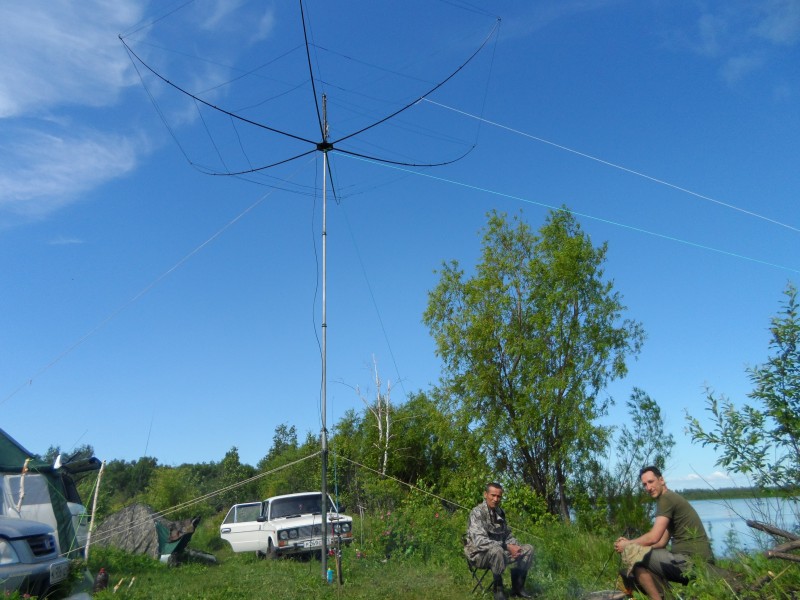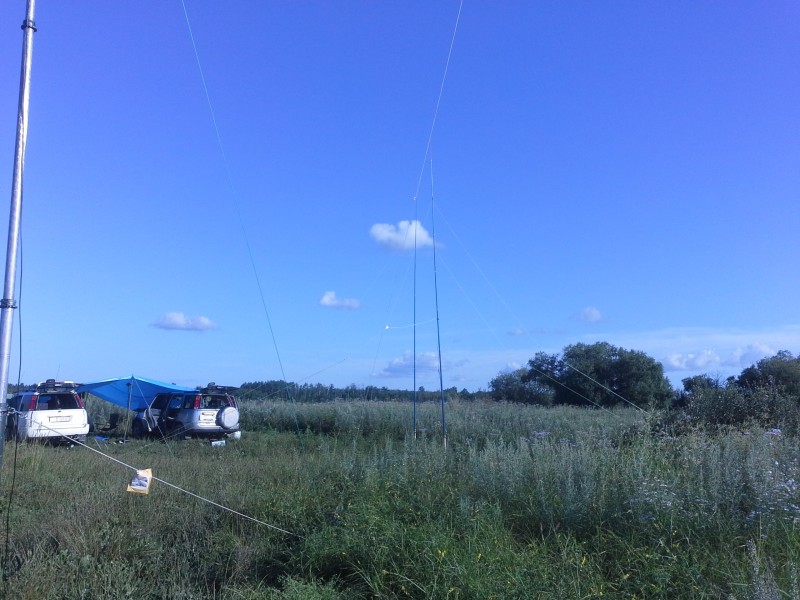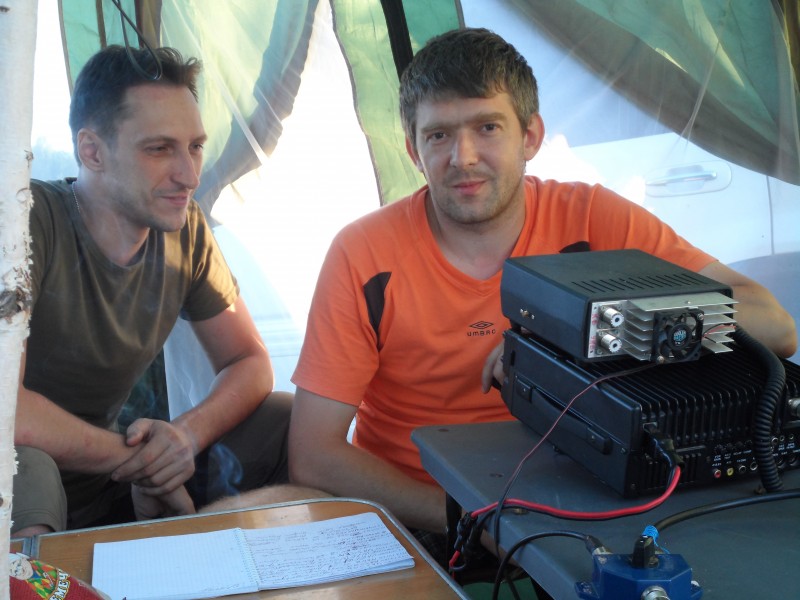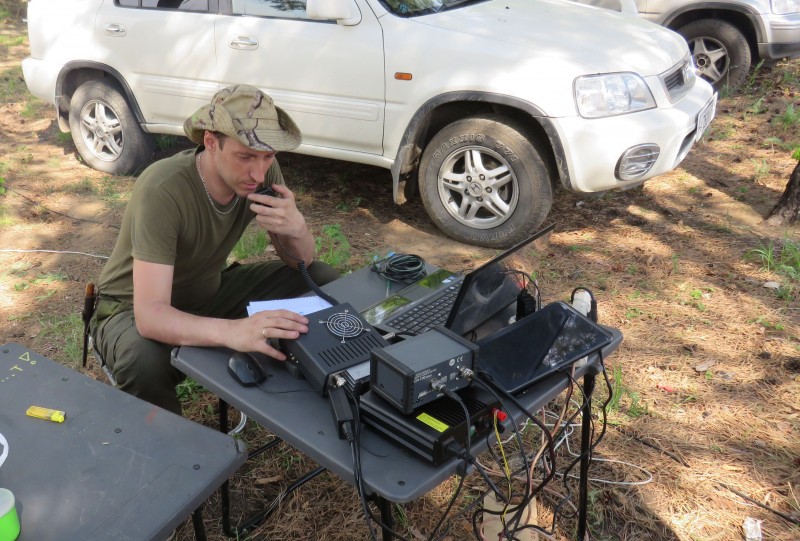Field Amateur Radio or Field Driving Theory
In this publication I would like to slightly open up the topic of amateur radio in general and amateur field radio. There is not yet a detailed description of the equipment and antennas. Unfortunately on Hiktayms very little information about amateur radio and radio amateurs. If this topic is interesting to someone, then in new publications I will talk about our equipment and antennas.
What is the difference between a home amateur radio and a field amateur radio? ... But no. Who is such a radio amateur? A radio amateur is a person who is interested in radio communication in amateur use. That is, this is a person who is interested in talking on the radio, and the more interesting the interlocutor. For example, you can ask about the weather a person from Australia being in the Far East of Russia. What is the point you ask, because you can call or chat over the Internet? And the point is that it is much more difficult to do on the radio and it means much more interesting. After all, for this you need to have radio equipment, antennas, feeder lines, a lot of things, and of course knowledge and interest. However, knowledge is just what is extracted in the process and more experience. So, how does a home amateur radio differ from a field amateur radio amateur? The home radio amateur equipment is at home, and antennas on the roof or on the mast near the house, as a rule, the antenna is large and stationary, there is a powerful amplifier, a computer and a cup of coffee at hand. In a field radio amateur, on the contrary, as a rule, a transceiver with a relatively small output power, often small-sized. A generator or just a battery. Tent. Light field mast and light field antennas, often self-made. And this is just the most interesting. Earlier, radio amateurs made the transceivers themselves, almost without exception. Now this is the lot of the most, and the vast majority works on factory equipment. But antennas, antennas are just very interesting to do yourself, because if the transceivers are all about the same, then the antenna in this case determines the quality of the connection and how far away and therefore interesting correspondents will answer you. But in the field you will not take out a large stationary antenna, which means you have to invent light, fast-assembled and, most importantly, EFFECTIVE field antennas. And of course, crystal clear field broadcast, away from the city. In recent years, the wholesale dominance of pulsed power supplies in any technology has led to the fact that the broadcast in the city is very noisy, but in the field ... there it is clean as a tear, no noise and crackling. But there are also graduate programs, for example, to establish links with all regions of Russia (the RDA program) and many, many others.
The field day begins with preparation, since we prefer to work on the RDA graduate program, at first we evaluate different areas of our Amur region in terms of interest for radio amateurs around the world. In this regard, it is not difficult for us to choose, only the districts of three large cities and even a couple of districts where there are strong and permanently working radio amateurs are well-developed. The remaining areas are practically not represented on the air. Then we look for an interesting place on the map. Further online announcements are left in which it is indicated that a certain area of RDA will work on certain days. Of course, this is to some extent not fair, but in one such area we leave no more than once a year and we want more people from all over the world to get it for themselves, that is, to establish and record the connection (in amateur radio language this is called QSO).
Our equipment set is already standard in principle: a generator, a battery, transceivers, several antennas. And of course camp equipment, tents, pots and more.
Upon arrival at the site, the antennas are deployed first and a place is determined for the field shack. The marquee is a marquee tent, and often just a table under a pine tree. Directional antennas are deployed on light field masts with stretch marks. Also, fishing poles often act as masts, for example, vertical deltas we put on fishing rods. Dipole antennas are stretched between trees. Generally, fishing rods are an indispensable material for a field radio amateur; they are used as masts and as material for the antennas themselves.
After that, the equipment is installed in the neck, the feeder is pulled from the antennas and the power supply cable from the generator and work begins.
As you know, work at different frequencies is carried out with the greatest efficiency at different times of the day. There are day, evening and night ranges. Our main range is 20 meters (middle about 14.170 MHz). On this range, you can work quite comfortably in the morning, in the afternoon, in the evening and at night, depending on the time of day and solar activity, the passage changes. Plus, the difference in time zones also affects, therefore, being in the +9 GMT zone, we already collect the main connections in the evening and night time. The main work begins after the information about us is placed in the amateur radio cluster, these are special sites on the Internet, something like a live chat, where information about who, at what frequency and where is working at the current time is laid out. If everything is going well, the passage is good, then hams from all over the world begin to “approach” the frequency occupied by us, a queue of amateurs is formed and everyone tries to shout down each other, this phenomenon is called “pileup” (pile-up) small ”English.) it is very interesting to rake such a pile, after a while the language starts to stumble, while in an hour it is possible to make hundreds of QSOs and with a certain experience even more, and it can last for hours and then you have to change the operator for that just to give it a rest. This, of course, is about communication in SSB modulation, that is, with a voice that is the most interesting mode for me. The preference is usually given to the most distant and weak stations and only later to the more near ones.
Separately, I want to note the field trips weekend. These activities are not so serious at all; they usually take with them a fast-build single-band vertical from a fishing rod and a transceiver. The antenna is installed in the field and the connection is from the car. Despite the fact that the antenna is very simple and uncomplicated, sometimes it is possible to make quite interesting connections on highways with a length of up to 6-7 thousand km.
I want to finish with a few photos taken at different field trips.
Six-band Spider type antenna, ranges 6-10-12-15-17-20 meters:

Single-band three-element shortened Yagi 20 meters:

Double vertical delta at 15 meters (fishing rods in the background):

Some of our equipment and us in the tent-neck:

Actively working in the "shek" under the pine:

My first story turned out to be very simple and introductory, there were many questions behind the scenes about what we use transceivers, how we do and use our antennas, I hope that if you are interested, I will return in more detail to these topics.
What is the difference between a home amateur radio and a field amateur radio? ... But no. Who is such a radio amateur? A radio amateur is a person who is interested in radio communication in amateur use. That is, this is a person who is interested in talking on the radio, and the more interesting the interlocutor. For example, you can ask about the weather a person from Australia being in the Far East of Russia. What is the point you ask, because you can call or chat over the Internet? And the point is that it is much more difficult to do on the radio and it means much more interesting. After all, for this you need to have radio equipment, antennas, feeder lines, a lot of things, and of course knowledge and interest. However, knowledge is just what is extracted in the process and more experience. So, how does a home amateur radio differ from a field amateur radio amateur? The home radio amateur equipment is at home, and antennas on the roof or on the mast near the house, as a rule, the antenna is large and stationary, there is a powerful amplifier, a computer and a cup of coffee at hand. In a field radio amateur, on the contrary, as a rule, a transceiver with a relatively small output power, often small-sized. A generator or just a battery. Tent. Light field mast and light field antennas, often self-made. And this is just the most interesting. Earlier, radio amateurs made the transceivers themselves, almost without exception. Now this is the lot of the most, and the vast majority works on factory equipment. But antennas, antennas are just very interesting to do yourself, because if the transceivers are all about the same, then the antenna in this case determines the quality of the connection and how far away and therefore interesting correspondents will answer you. But in the field you will not take out a large stationary antenna, which means you have to invent light, fast-assembled and, most importantly, EFFECTIVE field antennas. And of course, crystal clear field broadcast, away from the city. In recent years, the wholesale dominance of pulsed power supplies in any technology has led to the fact that the broadcast in the city is very noisy, but in the field ... there it is clean as a tear, no noise and crackling. But there are also graduate programs, for example, to establish links with all regions of Russia (the RDA program) and many, many others.
The field day begins with preparation, since we prefer to work on the RDA graduate program, at first we evaluate different areas of our Amur region in terms of interest for radio amateurs around the world. In this regard, it is not difficult for us to choose, only the districts of three large cities and even a couple of districts where there are strong and permanently working radio amateurs are well-developed. The remaining areas are practically not represented on the air. Then we look for an interesting place on the map. Further online announcements are left in which it is indicated that a certain area of RDA will work on certain days. Of course, this is to some extent not fair, but in one such area we leave no more than once a year and we want more people from all over the world to get it for themselves, that is, to establish and record the connection (in amateur radio language this is called QSO).
Our equipment set is already standard in principle: a generator, a battery, transceivers, several antennas. And of course camp equipment, tents, pots and more.
Upon arrival at the site, the antennas are deployed first and a place is determined for the field shack. The marquee is a marquee tent, and often just a table under a pine tree. Directional antennas are deployed on light field masts with stretch marks. Also, fishing poles often act as masts, for example, vertical deltas we put on fishing rods. Dipole antennas are stretched between trees. Generally, fishing rods are an indispensable material for a field radio amateur; they are used as masts and as material for the antennas themselves.
After that, the equipment is installed in the neck, the feeder is pulled from the antennas and the power supply cable from the generator and work begins.
As you know, work at different frequencies is carried out with the greatest efficiency at different times of the day. There are day, evening and night ranges. Our main range is 20 meters (middle about 14.170 MHz). On this range, you can work quite comfortably in the morning, in the afternoon, in the evening and at night, depending on the time of day and solar activity, the passage changes. Plus, the difference in time zones also affects, therefore, being in the +9 GMT zone, we already collect the main connections in the evening and night time. The main work begins after the information about us is placed in the amateur radio cluster, these are special sites on the Internet, something like a live chat, where information about who, at what frequency and where is working at the current time is laid out. If everything is going well, the passage is good, then hams from all over the world begin to “approach” the frequency occupied by us, a queue of amateurs is formed and everyone tries to shout down each other, this phenomenon is called “pileup” (pile-up) small ”English.) it is very interesting to rake such a pile, after a while the language starts to stumble, while in an hour it is possible to make hundreds of QSOs and with a certain experience even more, and it can last for hours and then you have to change the operator for that just to give it a rest. This, of course, is about communication in SSB modulation, that is, with a voice that is the most interesting mode for me. The preference is usually given to the most distant and weak stations and only later to the more near ones.
Separately, I want to note the field trips weekend. These activities are not so serious at all; they usually take with them a fast-build single-band vertical from a fishing rod and a transceiver. The antenna is installed in the field and the connection is from the car. Despite the fact that the antenna is very simple and uncomplicated, sometimes it is possible to make quite interesting connections on highways with a length of up to 6-7 thousand km.
I want to finish with a few photos taken at different field trips.
Six-band Spider type antenna, ranges 6-10-12-15-17-20 meters:

Single-band three-element shortened Yagi 20 meters:

Double vertical delta at 15 meters (fishing rods in the background):

Some of our equipment and us in the tent-neck:

Actively working in the "shek" under the pine:

My first story turned out to be very simple and introductory, there were many questions behind the scenes about what we use transceivers, how we do and use our antennas, I hope that if you are interested, I will return in more detail to these topics.
All Articles